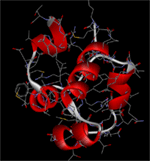| SCORING FUNCTION FOR PROTEIN STRUCTURE EVALUATION |
|
 |
| CRO Repressor Protein |
|
|
This utility calculates energy of a given protein using an all atom energy based empirical scoring function.
|
| The scoring function considers the non-bonded energy of a protein, expressed as a sum of three terms - electrostatics, van der Waals and hydrophobicity. |
|
ETotal = ∑( Eel + Evdw + Ehpb )
|
Eel is the electrostatic contribution to the energy, Evdw is the van der Waals term, Ehpb is the hydrophobic contribution and the summation runs over all the atoms of the protein [1-4].
|




